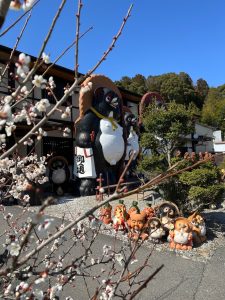信楽へ行ってきました。(愛知県名古屋市千種区姫池通 骨董品買取 古美術風光舎)
2024.03.02
みなさまこんにちは、スタッフYでございます。
三月に入り花粉が気にはなりますが、そろそろじっとしていられない方、いらっしゃるのではないでしょうか。
そんな中スタッフY、先日信楽を訪れてみました。
旅の目的は信楽焼の土鍋ごはんを信楽焼の器で食すランチと信楽散策でして、久しぶりの信楽、お天気にも恵まれ楽しい旅でありました。
本日はその旅行記ブログ、すこしお付き合いくださいませ。
名古屋から車で一時間半。
信楽は、日本六古窯のひとつである信楽焼が有名な街ということはご周知とは思いますが、そう、あの人気NHKドラマ「スカーレット」の舞台にもなった場所でもあります。各所にロケの舞台になった場所があったり(ロケ地巡りもの楽しい。)信楽焼の陶芸体験ができる施設がたくさんあり、また、街を歩いているとたくさんの信楽焼のたぬきがお出迎えをしてくてれます。

また、陶芸体験が楽しめるスポットや信楽の豊かな自然を満喫できるスポットなどもあり、今回伺った土鍋のお店も信楽焼を使用しておりまして、そんな器を使ったカフェや食事のできるお店ものどかな風景の中にできていたり。なんとも癒される街であります。
やはり旅のテーマは信楽焼になるのですが、
信楽焼は主に滋賀県甲賀市信楽町周辺で生産されているのですが、それはやはり付近の丘陵から良質の陶土がでる土地柄であるからのようです。その丘陵の道沿いにたくさんの窯元が連なっており、その風景も趣があります。
それゆえ日本を代表する陶磁器として日本六古窯のひとつにも数えられ、これまで多くの作品が生み出されてきました。

登り窯のあとがカフェになっていました。

こちらはギャラリーに
その独特な風合いは、陶土に木節(きぶし)・実土(みづち)・蛙目(がいろめ)など、さまざまな種類の粘土を混ぜて作られており、ほかにも複数の原料を使って作っているため、コシがあって肉厚な焼物に仕上がります。
また、材料となる粘土がしっかりとしているので、大きな焼物を作るのにも向いており、その耐火性も高く、高温で焼くことで独特な風合いになるのも魅力のひとつであります。それゆえ焼き方や窯の中の温度などにより、仕上がりが変化するのも面白いポイントでして、ひとつひとつの作品が個性に溢れているため選ぶのが楽しい焼物でもあります。
中世から現在まで生産が続けられている信楽焼の歴史は古く、なんと742年聖武天皇が紫香楽宮の造営に着手したときに、布目瓦や汁器の須恵器を焼いたのが始まりという説があることも驚きですが、紫香楽宮跡も見ることができますが、ここに都が栄えていたことも驚きですね。
ですが、どことなく野性味あふれる肌感が確かに須恵器を思い起こすような気もします。また、当時すでに発展し始めていた常滑焼の技術を取り入れ徐々に発展していったとされており、当時から窯元同士の交流があったようですから、当時の職人さんたちも探求熱心だったのでしょうね。
明治時代以前に作られていた釉薬をかけない焼物は「古信楽」と呼ばれるのですが、室町時代末期頃までは壺などを中心に作られておりました。その後、江戸時代の茶の湯の大衆化により信楽焼は一気に発展していきますが、江戸時代末期になると陶業地として栄えますがその後は不況を迎えます。理由は金属製品などが普及したことにより、信楽焼のような陶磁器の需要が激減してしまったためです。
ですが時代が進むと、不況を打破するために信楽焼のタイルや傘立てなどが作られるようになり、明治時代になると、現在でもよく見かけるたぬきの置物が作られ始めました。ここでやっとたぬきの登場です。そんなたぬきの置物を気に入った昭和天皇が、信楽行幸の際に歌に詠まれたのがきっかけで全国に広まったといわれております。
そういえば、なぜ信楽は「たぬき」なのかいつも不思議に思っており、一つ謎が解けました。

ちなみにたぬきには「た(他)」「ぬき(抜く)」=「他を抜く」という意味に通じるため、「商売繁盛の縁起物」という意味をなしており、昔から店先に置かれておりますが、ちょっと気になったので、信楽周辺のお宅の玄関先を車越しに勝手に調査いたしますと…。
たぶん近隣の95%くらいのお宅の玄関先にたぬきが置かれていたのではないでしょうか。(スタッフY調べ)

そんなたぬき設置調査をしながら信楽を後にいたしましたが、信楽とても癒されるところでありました。
この春の旅の候補に入れてみてはどうでしょか。
それではごきげんよう。
Hello everyone, this is Staff Y.
It’s March and pollen is a concern for some of you, but I think it’s time for those of you who cannot stay still.
In the midst of all this, Staff Y visited Shigaraki the other day.
The purpose of the trip was to have a lunch of rice cooked in a Shigaraki earthenware pot with Shigaraki ware and to walk around Shigaraki.
It was my first visit to Shigaraki in a long time, and the weather was perfect, so please bear with me for a moment as I write about my trip.
Shigaraki is an hour and a half drive from Nagoya.
As you may know, Shigaraki is famous for Shigaraki ware, one of the six oldest kilns in Japan, but it was also the setting for the popular NHK drama “Scarlett. There are many places where the drama was filmed (it is fun to visit the filming locations). There are many facilities where you can experience Shigaraki pottery making, and many Shigaraki tanuki (raccoon dogs) will welcome you when you walk around the town.
The earthenware pot store we visited this time also uses Shigaraki ware, and there are also cafes and restaurants in the tranquil scenery that use such ware. It is a very relaxing town.
The theme of my trip will be Shigaraki ware,
Shigaraki ware is mainly produced in the area around Shigaraki Town, Koka City, Shiga Prefecture, because the hills in the vicinity produce high-quality potter’s clay. Many kilns are located along the road along the hillside, and the scenery is very picturesque.
The area is also known as one of the six oldest kilns in Japan and has produced many works of ceramics and porcelain representing Japan.
After the climbing kilns, there is a café.
This one is now a gallery.
The unique texture of this pottery is created by mixing various types of clay, such as kibushi, mizuchi, and garome, with other materials, resulting in thicker and firmer pottery.
The clay is also suitable for making large pieces of pottery because of its firmness, and its high fire resistance is one of its charms, giving it a unique texture when fired at high temperatures. It is interesting to note that the finish changes depending on the firing method and the temperature in the kiln, and each piece is unique, making it a fun pottery to choose.
The history of Shigaraki ware, which has been produced from the Middle Ages to the present, is long, and it is surprising that it is said to have started when Emperor Shomu started building the Shikaraku Palace in 742, when he fired Nunome tiles and Sue ware (soup bowls).
However, the somewhat wild skin texture certainly reminds us of Sue ware, doesn’t it? It is also said that the pottery gradually developed by adopting the techniques of Tokoname ware, which had already begun to develop at that time, and since there seems to have been exchange between potters from that time, the craftsmen of that time must have been eager to explore.
Unglazed pottery made before the Meiji period is called “Koshigaraki,” and until around the end of the Muromachi period, it was mainly made into pots. Later, with the popularization of the tea ceremony in the Edo period, Shigaraki ware developed rapidly, but at the end of the Edo period, it flourished as a ceramic production center, but then entered a period of recession. The reason for this was that the demand for ceramics such as Shigaraki ware declined drastically due to the spread of metal products.
As time went on, Shigaraki-ware tiles and umbrella stands were produced to break the depression, and in the Meiji period (1868-1912), tanuki figurines, which are still commonly seen today, began to be produced. This is where the tanuki finally made its appearance. It is said that Emperor Showa, who was pleased with these tanuki figurines, wrote a poem about them when he went to Shigaraki, and this is how they spread throughout the country.
Come to think of it, I always wondered why Shigaraki is called “Tanuki.
By the way, “tanuki” has the meaning of “good luck charm for prosperous business” because “tanuki” means “to overtake others” and “nuki” means “to overtake others”. I was a little curious, so I took the liberty of checking the entrances of homes in the Shigaraki area. I guessed that about 95% of the houses had a tanuki at their entrance (according to our staff Y). (According to Staff Y’s survey).
We left Shigaraki with such a survey of tanuki placement, and found Shigaraki to be a very relaxing place.
Why don’t you include Shigaraki as a candidate for your trip this spring?
Good bye.
*******************
ご実家の整理やお片付けなどをされている方のご相談などが多くございます。
お片付けなどくれぐれもご無理のないようになさってくださいませ。
風光舎では古美術品や骨董品の他にも絵画や宝石、趣味のお品など様々なジャンルのものを買受しております。
お片付けをされていて、こういうものでもいいのかしらと迷われているものでも、どうぞお気軽にご相談下さいませ。
また風光舎は、出張買取も強化しております。ご近所はもちろん、愛知県内、岐阜県、三重県その他の県へも出張いたします。
まずは、お電話お待ちしております。
愛知県名古屋市千種区姫池通
骨董 買取【古美術 風光舎 名古屋店】
TEL052(734)8444
10:00-18:00 OPEN

